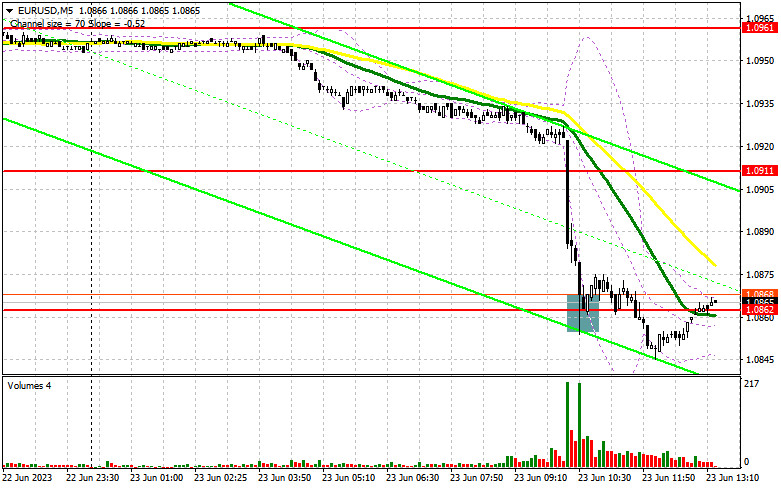
In my morning forecast, I emphasized the level of 1.0862 and suggested basing trading decisions on it. Let's examine the 5-minute chart and analyze the events that unfolded. The euro experienced a drop and a false breakout, which indicated a signal to buy. Still, I did not witness a significant upward movement when writing this article. The technical outlook has been revised for the second half of the day.

To open long positions on EUR/USD:
During the first half of the day, the disappointing PMI data for the Eurozone led to a rapid decline in the euro, signaling a diminished desire to buy following the European Central Bank meeting without new guidelines. In the second half of the day, similar reports on the manufacturing sector activity index, services sector activity index, and composite PMI figure for the United States are expected. Considering the current positive state of the US economy, we can anticipate the further downward movement of the currency pair if these indicators are better than economists' forecasts. The speeches by FOMC members James Bullard and Raphael Bostic will have a secondary impact.
In the event of a continued decline in the euro, a favorable buying signal will only emerge if a false breakout forms around the new support level of 1.0846. This would allow bulls to attempt to reach the resistance level of 1.0890, which was formed in the first half of the day. A breakthrough and subsequent test of this range from above to below could reignite demand for the euro, potentially pushing it towards 1.0929, where the moving averages are slightly higher. The ultimate target remains around 1.0966, where I would take a profit.
In the scenario of a decline in EUR/USD and the absence of buyers at 1.0846 in the second half of the day, which is quite likely, bears may attempt to take control of the market. Hence, a signal to buy would only arise if a false breakout occurs around the next support level of 1.0808. I would enter long positions immediately after a rebound from the minimum of 1.0777, aiming for an upward correction of 30–35 points within the day.
To open short positions on EUR/USD:
Sellers achieved their target in the morning, and it is now crucial to prevent the pair from surpassing 1.0890, as weak ISM statistics could trigger a surge in that scenario. Therefore, I will only consider short positions if there is growth and a false breakout around the new resistance level of 1.0890. A failed consolidation at that level would signal a sell-off, potentially pushing EUR/USD back to 1.0846, the newly formed support level from the first half of the day, which also holds significant short-term importance. A breakthrough below this range, followed by a downward test from below to above, could lead directly to 1.0808. The ultimate target would be the minimum of 1.0777, where I would take profit.

If there is an upward movement of EUR/USD during the American session and bears are absent at 1.0890, bulls may attempt to compensate for part of the decline by the end of the day. In such a case, I would postpone short positions until the next resistance level at 1.0929. Selling could also be considered there, but only after a failed consolidation. I would open short positions immediately upon a rebound from the maximum of 1.0966, aiming for a downward correction of 30-35 points.
In the COT (Commitment of Traders) report for June 13, there was a reduction in both long and short positions. However, it is important to note that the report was released before the Federal Reserve decided on interest rates, which remained unchanged in June of this year and significantly influenced the market's balance of power. Consequently, the current report is free of special attention. What is important to consider is that the demand for the euro has been sustained due to the European Central Bank's continued aggressive policy and is expected to persist. In the current conditions, the optimal medium-term strategy would be to buy during declines. According to the COT report, non-commercial long positions decreased by 9,922 to 226,138, while non-commercial short positions fell by 3,323 to 74,316. The overall non-commercial net position decreased to 151,822 from 158,224 at the end of the week. The weekly closing price increased from 1.0702 to 1.0794.
Indicator signals:
Moving Averages
Trading is taking place below the 30-day and 50-day moving averages, indicating a further decline of the pair.
Note: The period and prices of the moving averages discussed by the author are based on the H1 hourly chart and differ from the general definition of classical daily moving averages on the D1 daily chart.
Bollinger Bands
In the case of an upward movement, the upper boundary of the indicator around 1.0929 will act as resistance.
Description of Indicators
• Moving average (determines the current trend by smoothing volatility and noise). Period 50. Marked in yellow on the chart.
• Moving average (determines the current trend by smoothing volatility and noise). Period 30. Marked in green on the chart.
• MACD indicator (Moving Average Convergence/Divergence) Fast EMA period 12. Slow EMA period 26. SMA period 9.
• Bollinger Bands. Period 20.
• Non-commercial traders - speculators such as individual traders, hedge funds, and large institutions using the futures market for speculative purposes and meeting specific requirements.
• Non-commercial long positions represent the total long open positions of non-commercial traders.
• Non-commercial short positions represent the total short open positions of non-commercial traders.
• The total non-commercial net position is the difference between non-commercial traders' short and long positions.